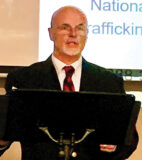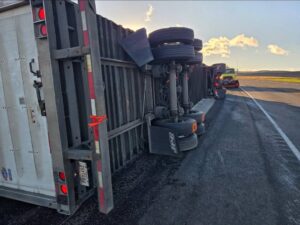WASHINGTON — Human trafficking is one of the fastest-growing global criminal enterprises, and is estimated to be a $150 billion industry. Today, there are an estimated 40 million men, women and children across the world trapped in this web of modern-day slavery.
Each January, during National Slavery and Human Trafficking Prevention Month, Trucking Moves America Forward (TMAF) shines a light on the dark practice of human trafficking.
“The trucking industry is uniquely positioned to help combat this epidemic by operating as America’s eyes and ears on the road,” TMAF officials said.
Truckers Against Trafficking (TAT) seeks to “raise up a mobile army of transportation professionals in the fight against human trafficking” through training on the warning signs of this crime and how to aid law enforcement, according to TMAF.
Following are stories from four professional truck drivers who are ambassadors for TAT and who have seen first-hand how the issue of human trafficking touches the trucking industry.
GARY SMITH

Gary Smith is an over-the-road truck driver from Ohio for Garner Trucking. He has been driving for more than 13 years, and operates in the nation’s upper Midwest region. In 2017 he was selected to be an America’s Road Team (ATA) captain and an ambassador for TAT.
Smith recently shared a story about a time when he was a new truck driver, and a young woman came knocking on his truck door in the middle of the night at a truck struck.
“I expected to see another truck driver saying that I was blocking him in, but standing outside my door in a torrential downpour, was a young girl — as young as maybe 15 or 16 years old — and she asked me if I wanted some company,” Smith recalled.
“I told her to go away, and she just stared at me momentarily and then turned and walked away. Because of ignorance and a lack of awareness about human trafficking, I never gave that young girl a chance to be rescued,” he said. “I wish I could turn back the hands of time, but what I can do now is educate others.”
Regrets about this experience led Smith to become TAT-certified in 2014. He now works to educate truck drivers and the general public about the horrors of human trafficking.
“I try to talk to everyone I can,” he said. “The more people that understand human trafficking and realize that it is real and understand that it could be one of your children or grandchildren snatched off the street and sold into slavery, increases the number of people who can help.”
Speaking about meeting and working with Survivors, Gary said, “When they tell you their stories about what their lives were like, you can’t even fathom that people would treat another person that way. When I hear these stories about how people treat other people, a righteous indignation rises up inside of you and you realize this has to stop. You are called to action.”
When educating people about what they can do to help, Gary said, “It’s about raising your level of situational awareness. Human trafficking is real: it’s happening in our backyard, and we need to be more aware of it. I tell people: keep your eyes open. If you see something, say something. Make the call. Save a life.”
Smith said it’s vital that truckers know the warning signs of human trafficking so they can spot and potentially help rescue victims.
“I still see that young girl’s face outside my truck. I don’t know if I’ll ever get the opportunity to save a victim, but as long as I can educate as many people as possible, I know that I can do my part and help make a difference,” Smith concluded.
RHONDA HARTMAN

Rhonda Hartman, who lives in Iowa, is a less-than-truckload driver for Old Dominion Freight Line. She began her trucking career as an owner-operator and has been a professional truck driver for more than 38 years. She has accumulated more than 2.8 million accident-free miles.
The first time Hartman believed she witnessed human trafficking, she said didn’t know what to do.
“I was driving late at night when a van came flying down the highway next to my truck,” Hartman recalled.
“Normally, I don’t look down at vehicles, but something inside me told me to look down into this van,” she said. “I saw several small children in car seats that were bolted to the floor. The children were all crying. The woman driving the van was alone in the front and there were no other adults with her. I felt instantly that these children had all been abducted. I felt this had to have been a transport.”
This event happened in the days before cellphones, and unfortunately, the van got away before Hartman was able to get in touch with someone by radio to call 911. To this day, she does not know if the children were ever rescued.
This event had such an impact on Smith that it moved her to learn more about human trafficking and how to report it, which led her to become an ambassador for TAT. She now works to educate other drivers.
“I make it personal: This could be your child, grandchild or sibling,” she said, adding that it’s better to call for help and be wrong about suspicious activity than to do nothing and be right.
Rhonda also discussed the advantage that truck drivers have in the war against trafficking.
“Truck drivers are often overlooked because people are so used to seeing trucks on the road, but since we’re always paying attention and alert, we are able to see everything around us,” she said. “As truck drivers, we are the eyes and ears on the road. We can see things that the public and even law enforcement cannot.”
BILL KROUSE

Third-generation driver Bill Krouse, who lives in Minnesota, has been a trucker for 38 years. He has been driving for YRC Freight/Yellow Corp. for the past 35 years, hauling non-refrigerated goods, and has accrued more than 3 million accident-free miles throughout his career.
When Krouse was first approached by TAT, he said he wasn’t aware about the human trafficking crisis.
“Once I found out about it, I had to act,” he said. “I watched one of TAT’s videos and I said to myself, ‘This is something I feel in my heart that I can talk to people about and make a difference.’”
Krouse become TAT-certified last year.
“Now, I know what to look for,” he said. “I’m much more aware of my surroundings than I was before and I’m always watching to see if anything is out of the ordinary.”
Krouse reiterated the importance of the trucking industry in the fight against human trafficking.
“We’re all over the country,” he said. “That’s over 3 million drivers who can be scanning streets across the country. If you factor in all of the other transportation drivers, like bus drivers, taxi drivers and others, that’s a lot of people who can help call something in.”
Krouse advises drivers to keep an eye out in specific areas that are considered high traffic areas for human trafficking, such as rest areas, truck stops, restaurants and hotels.
TIM TAYLOR

Tim Taylor has been a professional truck driver for more than 30 years and has been driving with FedEx Freight for 27 of those years. He lives in Georgia.
While attending the Georgia Truck Driving Championships in the early 2000s, Taylor was approached by a TAT representative who was educating drivers about the organization. Taylor went through the certification process and learned to spot the common signs of human trafficking so he would know what to look for while on the road.
“TAT opened my eyes to the human trafficking crisis,” he said. “I learned the signs to watch and listen for that someone that may be in a human trafficking situation may be presenting.”
After learning more about human trafficking and the warning signs, Taylor said believes he came across a victim earlier in his career before he was TAT-certified.
He recalled pulling into a gas station in Florida one night to park. A car pulled up next to his truck.
“A young teenage girl came out of the car dressed provocatively,” he said. “She started towards us and offered commercial sex that night.”
Because of the age of the girl and the fact that she was with an older woman, whom Taylor describes as “grandmotherly,” he was concerned.
“I knew it my heart and my gut that something was wrong,” he said. “We told her we weren’t interested and left. Knowing now what I know, I wish I would have known back then. I believe that older woman was in control of that girl. If that was to happen to me now, I would know what to do.”
Since becoming TAT-certified, Taylor works to educate others about the warning signs of human trafficking and what to do if they encounter a human trafficking situation.
“I wish we could get every truck driver that has a CDL TAT-trained. It’s so easy. It’s as easy as sitting at your computer or downloading an app,” he said.
“Whenever truck drivers get ready to haul our loads every day, we do a pre-trip on our tractors and trailers. We know what to look for; we’ve been trained on what to look form” he explained. “It’s the same with human trafficking; you’ve got to be trained.”
When a person is trapped in a human-trafficking situation, they are reliant on others for help, he noted.
“If a person is in a trafficking situation and nothing’s done, they’re going to remain in that trafficking situation. That’s a lifetime of trafficking,” Taylor said. “If one person can make a difference, one person is saved from modern day slavery.”
The Trucker News Staff produces engaging content for not only TheTrucker.com, but also The Trucker Newspaper, which has been serving the trucking industry for more than 30 years. With a focus on drivers, the Trucker News Staff aims to provide relevant, objective content pertaining to the trucking segment of the transportation industry. The Trucker News Staff is based in Little Rock, Arkansas.















